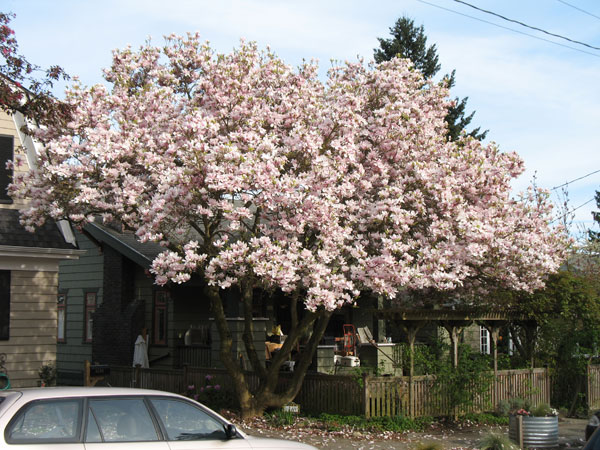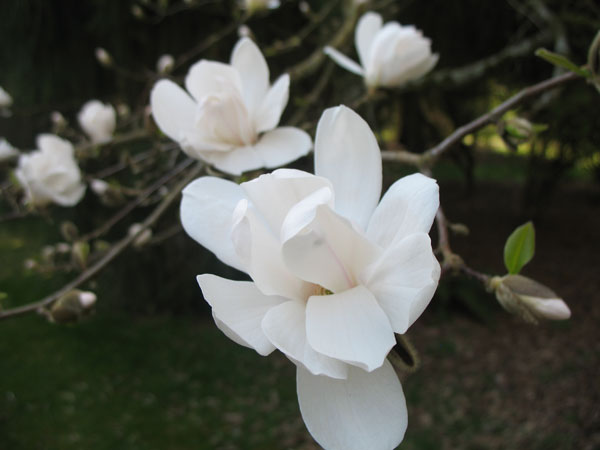Magnolias for Utah
by Michael Kuhns, Extension Forestry Specialist
It's tree planting time and Arbor Day month (remember Arbor Day in Utah is the last Friday in April) so I've started to wander through nurseries and garden centers to see what looks good, what I want, and what I can afford. I also use these wanders as a way to gauge the future diversity and quality of our urban/community forests because I figure that most of what I'm seeing in the nurseries now will make up our future landscapes.
So, yesterday I was looking through the tree and shrub section of a Logan garden center and found a beautiful small magnolia ready to bloom and bought it (it was 25% off). In particular it was a Magnolia liliflora or lily magnolia hybrid named 'Susan.' This purchase, and my love of magnolias, made me decide to feature magnolias when writing this article.
No member of the magnolia family (Magnoliaceae) is native anywhere near Utah. Most are native to East Asia and the Himalayas and to eastern North America and Central America. The nearest magnolias to Utah are native to the southeastern U.S. Yet I have been pleasantly surprised by how well many magnolias do in at least parts of Utah. Most don't like extreme dry conditions or poor drainage, but they can stand heat and are at least moderately tolerant of alkaline soil, salt, and shade.
Many magnolias are evergreen and fairly sensitive to cold, so planting a magnolia in Rich County might be a marginal proposition (try Kobus magnolia), yet even in cold climates they offer possibilities.
So let's start with one of our more cold-hardy (zone 4) magnolias - Magnolia stellata or star magnolia. Star magnolia is a multi-stemmed, non-evergreen shrub to small tree with beautiful, usually white but sometimes pink flowers with narrow strap-shaped petals. Four-inch flowers come on very early, before the leaves, and thus are very showy. Cultivars to consider are 'Royal Star' with large, white, fragrant flowers; 'Centennial;' and 'Dawn.' As with all magnolias, plant in a location that's at least somewhat protected from weather extremes, and especially from southern exposures that cause warming in the winter.

Another cold-hardy, non-evergreen magnolia that can be showier and more dramatic is Magnolia x soulangiana or saucer magnolia (note: the 'x' in the name indicates a hybrid). Like star magnolia it flowers before the leaves come on and is multi-stemmed, though larger than star magnolia. Most cultivars have 5" to 10" pink to purple flowers with round petals, but some are white. This tree is quite hardy and does as well in Logan as it does farther south. Try cultivars 'Brozzonii,' 'Lennei,' and 'San Jose.'
A large evergreen magnolia for warmer parts of Utah (its stated USDA cold hardiness zone is 6) is Magnolia grandiflora or southern magnolia (here's some tree trivia -- the street tree in front of Jerry Seinfeld's building in NYC in the Seinfeld sitcom is a southern magnolia). It's large, evergreen, oval leaves are dark shiny green on top and covered with rust-colored hairs beneath. Leaves normally live two years but may drop after one season in colder climates without much harm to the tree. Flowers are creamy-white and 8" to 12" in diameter, making this a spectacular tree in bloom. Though this tree isn't known to be very cold hardy, I have seen it doing well in Salt Lake City and Provo (as well as St. George) in Utah, and have seen it surviving in Columbia, Missouri (zone 5b). Numerous cultivars are available.
There's not room here to mention other magnolias in detail. Others worthy of mention (all are hardy at least to zone 4) are Kobus magnolia (Magnolia kobus), cucumber magnolia (Magnolia acuminata), and Loebner magnolia (Magnolia x loebneri). All have numerous cultivars available with a variety of sizes, shapes, and flower characteristics. And of course I think the lily magnolia (Magnolia liliiflora) I bought yesterday will do well, but I'll have to get home, plant it, and wait and see. Wish me luck.

Dr. Michael Kuhns
Extension Forester
Utah State University
April 2, 2001
(originally written for TreeUtah newsletter)

